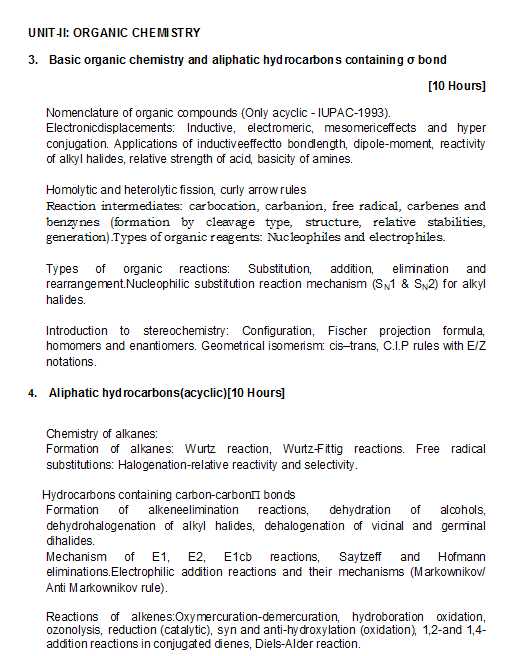|
#2
14th March 2017, 04:18 PM
| |||
| |||
| Re: Department of Chemistry Saurashtra University Rajkot
Yes, the Department of Chemistry of Saurashtra University Rajkot offers B.SC Chemistry Course. As you want course structure of B.SC Course, so here is complete course structure: Eligibility Criteria: Students must have passed class 12th with Science (PBC / PCM) stream from recognized Board. Duration: 3 Years Saurashtra University Rajkot B.Sc Chemistry Course Structure: Year I Semester I C-101: CHEMISTRY THEORY UNIT– I: INORGANIC CHEMISTRY 1. Atomic structure and periodic properties[10 Hours] Dual nature of electron, De-Broglie’s equation, Heisenberg’s uncertainty principle, quantum numbers, Aufbauprinciple, Pauli’s exclusion and Hund’s rule for electron configuration. Periodicity in atomic properties and its causes, explanation of general trends of periodic properties: atomic and ionic radii, ionization potential, electronegativity and electron affinity. Chemistry of s and p block elements Special characteristics such asmetallic character, polarizing power, hydration energy,inert pair effect, relative stability of different oxidation state, diagonal relationship of (1) lithium with magnesium (2) boron with silicon and (3) beryllium with aluminum, anomalous behavior of Li and Be, formation of complex compounds, catenation, allotropy (diamond and graphite-theirstructure, properties and its uses). 2. Chemical bonding in covalent compounds [10 Hours] Covalent bond: Valence bond theory and its limitations. Concept of hybridization: Basic concept of MO theory.Bonding and anti-bonding molecular orbitals.Gerade and ungerade molecular orbitals.σ-molecular orbital andσ*-molecular orbital, π- molecular orbital and π*-molecular orbital.Conditions for effective combinations of atomic orbitals.Energy level diagrams of B2, C2, N2, O2, F2, CO, NO, CO2 (with s-p mixing and orbital interaction) with calculation of bond order and magnetic moment.Comparison of MO theory and VB theory. UNIT-II: ORGANIC CHEMISTRY 3. Basic organic chemistry and aliphatic hydrocarbons containing σ bond Nomenclature of organic compounds (Only acyclic - IUPAC-1993). Electronicdisplacements: Inductive, electromeric, mesomericeffects and hyper conjugation. Applications of inductiveeffectto bondlength, dipole-moment, reactivity of alkyl halides, relative strength of acid, basicity of amines. Homolytic and heterolytic fission, curly arrow rules Reaction intermediates: carbocation, carbanion, free radical, carbenes and benzynes (formation by cleavage type, structure, relative stabilities, generation).Types of organic reagents: Nucleophiles and electrophiles. Introduction to stereochemistry: Configuration, Fischer projection formula, homomers and enantiomers. Geometrical isomerism: cis–trans, C.I.P rules with E/Z notations 4. Aliphatic hydrocarbons(acyclic)[10 Hours] Chemistry of alkanes: Formation of alkanes: Wurtz reaction, Wurtz-Fittig reactions. Free radical substitutions: Halogenation-relative reactivity and selectivity. Hydrocarbons containing carbon-carbonP bonds Formation of alkeneelimination reactions, dehydration of alcohols, dehydrohalogenation of alkyl halides, dehalogenation of vicinal and germinal dihalides. Mechanism of E1, E2, E1cb reactions, Saytzeff and Hofmann eliminations.Electrophilic addition reactions and their mechanisms (Markownikov/ Anti Markownikov rule). Reactions of alkenes:Oxymercuration-demercuration, hydroboration oxidation, ozonolysis, reduction (catalytic), syn and anti-hydroxylation (oxidation), 1,2-and 1,4- addition reactions in conjugated dienes, Diels-Alder reaction. Formation of alkynes: Dehydrohalogenation of vicinal and geminaldihalides, dehalogenation of tetrahalides Reactions of alkynes: Acidity, electrophilic addition reactions like halogenation, hydrohalogenation, hydration, hydroboration, addition of carbene and catalytic hydrogenation.Nucleophilic addition with hydrogen cyanide and alcohol, hydration to form carbonyl compounds, alkylation of terminal alkynes. UNIT III: PHYSICAL CHEMISTRY 5. Chemical kinetics Concept of chemical kinetic: rate of chemical reaction, concentration dependence of reaction rate specific reaction rate constant, order and molecularity of the reaction. Factors affecting rate of the reaction. Definition, derivation of integrated rate equations for zero, first and second (same and different reactants) order reactions, their characteristics and half -life periods. Determination of the order of reaction: (1) Hit and trial method or Integration method and its limitations (2)Fractional change method, (3) Oswald’s isolation method (4) graphical method and(5) van’t Hoff differential method. Concept of activation energy.Derivation of Arrhenius equation and determination of activationenergy by integrated equation andgraphical methods. Theories of reaction rates: Collision theory and absolute reaction rate theory of bimolecular reactions and qualitative comparison. Numericals 6. Adsorption Introduction, types of adsorption (physical and chemical), characteristics and factors affecting adsorption. Adsorption isotherm and Freundlich equation. Langmuir theory of adsorption: assumptions, derivation, modification in equation at very low and high pressure, limitations and applications of adsorption.   Last edited by Rajkumar Agarwal; 14th March 2017 at 04:23 PM. |